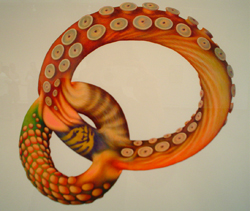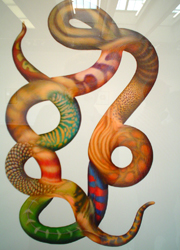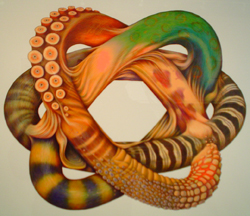
|
||
|
Portland art blog + news + exhibition reviews + galleries + contemporary northwest art
|
||
Mutatis Mutandis: New Work by Pat Boas The name of Pat Boas's new show, Mutatis Mutandis is a repetition of a single latin word in two different tenses. The Latin muto means change or transformation. The suffix atis identifies who witnesses the change, meaning essentially "you all see, or you all are seeing." The single word Mutatis has all the grammatical structure of an entire English sentence: You are all witnessing change.

Mutandis is another permutation of the root word muto, possibly referring to a singular subject as the witness of change. Unlike mutatis, I could find no legitimate Latin suffix that changes muto to mutandis. This suggests the word mutandis is simply an invented complement, a lyrical reiteration. The phrase Mutatis Mutandis functions as a spell or charm, its meaning welded to the musicality of its phrasing. Substituting a spell for a show title is appropriate to Boas's new work. The acrylic and ink paintings on paper explore themes of alchemical recombination. Boas scrutinizes animal physiology with the discerning eye of a field biologist and then mutates and combines observed details into recombinant geometric objects. Not recombinant animals, objects. 
The objects have animal aspects that do not give them life. They appear animated, alive, and even sentient, but their inherent animal life force is redirected into semiotic resonance. The objects are not simply visual abstractions; they are phonemes. Perhaps they are the letters of the language of spells. They are sigils, components of a language of great semiotic power; a language that reveals the secrets of disrupting the coherence of biological life. They appear to convey a meaning so significant, that it causes the letters themselves to burst into sudden, disorganized, animal life and crawl over the page, serifs gone to tentacles. And the phonemes are not flat, they are round and exist in a shallow space on the blank backgrounds. 
Alchemy itself, while laying the foundations of an organized study of chemistry and especially processes of refining minerals in the Middle Ages, was primarily a complex system of semiotic mysticism. Central to the discipline was the principle of sympathetic magic, a rejection of coincidental similarity. Sympathetic magic meant that all of nature was encoded with semiotic significance. If a certain tree's branches looked like the horns of an elk, the leaves of that tree in a tincture would imbue the essential properties of the animal to anyone who drank it. If an organ in the body also looked like an elk's horns, that organ could be restored to health by drinking the tincture. To the alchemist, all of reality was encoded as a language, which by degrees, through constant study, could be translated. Every object, every animal, every plant was a hieroglyph. Sympathetic magic created meaning by recombining and distilling the disparate forms of the natural world. Art theorist Jeanette Winterson's novel, Sexing the Cherry, explores alchemy as a process of semiotic encoding. Some of the pieces are clearly calligraphic letter forms, while others seem to have devolved into writhing tentacular labyrinths. The two most dimensional pieces are composed of interlocking rings and seem more like dynamic, spatially imagined diagrams than letter forms. One piece in particular, composed of three interlocking rings symmetrically and radially arranged immediately brings to mind the simplified diagrammatic model of the atom. Diagrammatic pieces bring another level of complexity to the work as a whole. While the other pieces seem to represent incomprehensible phonemes, these two communicate meaning as pictographs. The difference between these two pieces and the rest of the show, while pronounced, is not schismatic. This work has all been culled from the same alchemical spell book, much of the text, some of the diagrams. One wonders what we're being instructed in. The level of craft and scrutiny in this work are nothing short of astounding. Boas paints in acrylic ink with the precision of a scientific illustrator or a field biologist. Think of combining the sensibilities of John James Audubon and Nicholas Flammel. This work depends almost entirely on the illusion of texture and tactile response in the viewer; the rigidity of an alligator scale, the physical strangeness of an octopus tentacle emerging from striped ocelot fur. These textures are rich and detailed and luminous, Boas differentiates every hair from every other hair, allowing the viewer's eye to follow the detailed transitions from one animal type to another while tracing the arabesques of the larger forms. It would be interesting to see this work generate a book of some kind. With more pieces it could grow into an alphabet, each object could be further developed as a component of a larger, magical grammar structure. Mutatis Mutandis • through October 28th The Northview Gallery Portland Community College • Sylvania Campus 12000 Southwest 49th Ave • Portland • OR • 97219 Monday through Friday • 8:00 am - 4:00 pm • 503.977.4264 Posted by Isaac Peterson on October 25, 2005 at 8:47 | Comments (0) Comments Post a comment Thanks for signing in, . Now you can comment. (sign out)
(If you haven't left a comment here before, you may need to be approved by
the site owner before your comment will appear. Until then, it won't appear
on the entry. Thanks for waiting.)
|
| s p o n s o r s |
 |
 |
 |
 |
 |
 |
 |
 |
 |
 |
 |
 |
 |
 |

|
Site Design: Jennifer Armbrust | • | Site Development: Philippe Blanc & Katherine Bovee | |

